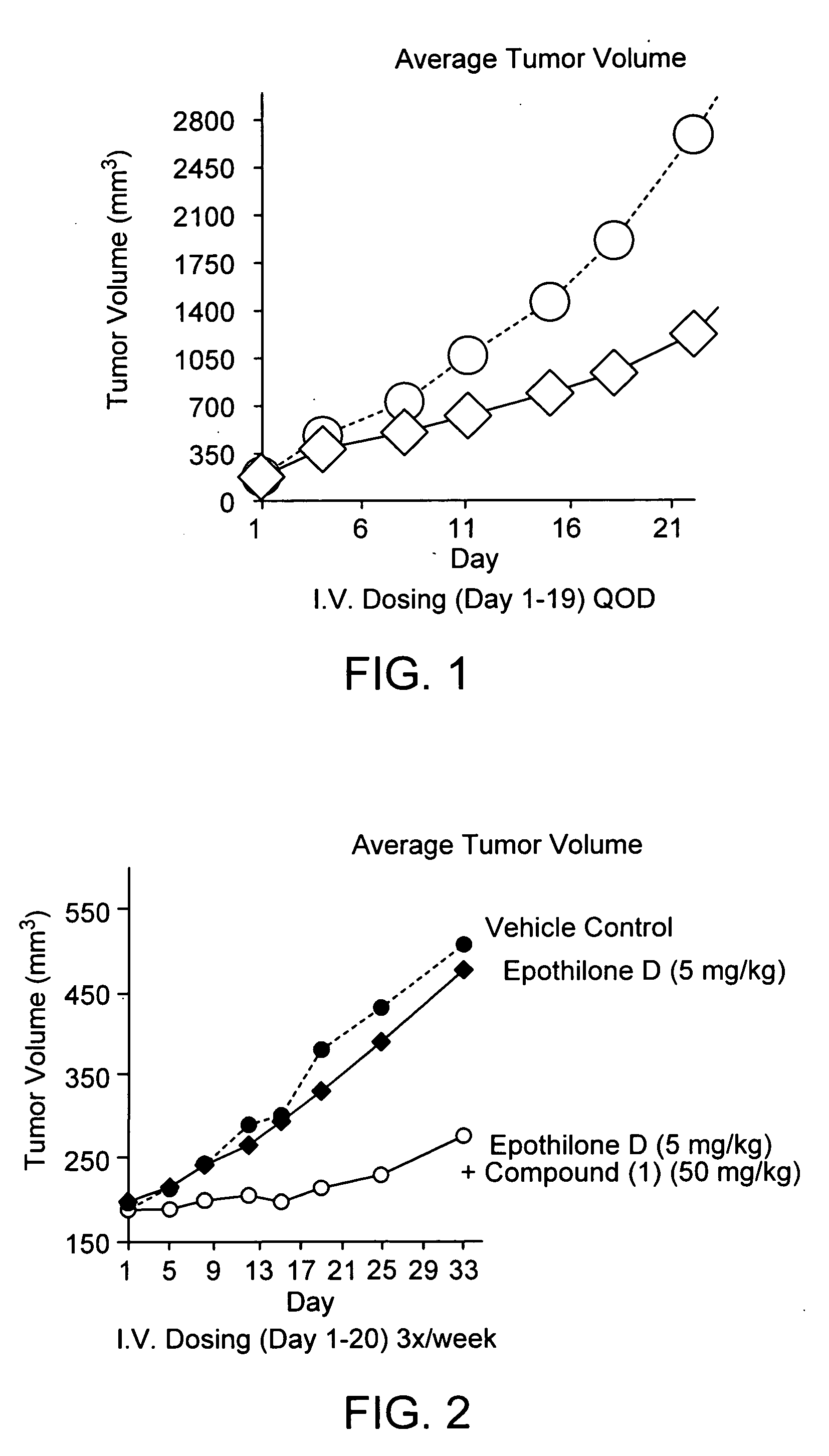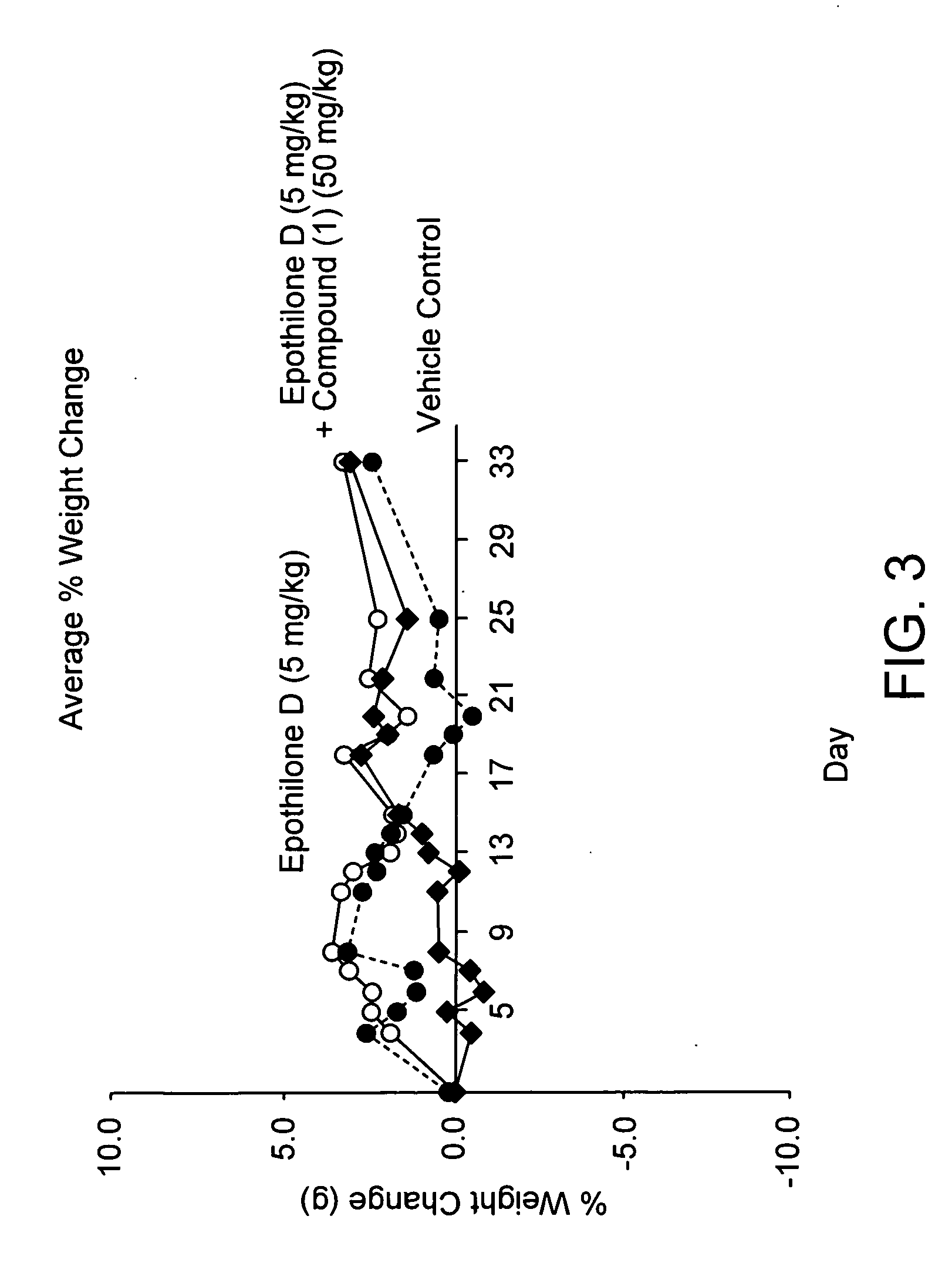Bis(thio-hydrazide amides) for treatment of hyperplasia
a technology of thiohydrazide and hyperplasia, which is applied in the direction of amide active ingredients, biocide, drug compositions, etc., can solve the problems of reblocked stented blood vessels, limited practical and cost limitations of therapy, and increase the therapeutic effect of the drug, so as to minimize side effects and improve the effect of therapeutic
- Summary
- Abstract
- Description
- Claims
- Application Information
AI Technical Summary
Benefits of technology
Problems solved by technology
Method used
Image
Examples
example 1
Multi-Drug Resistant Specific Anti-Cancer Activity Demonstrated In Vitro
[0142] The in vitro activity of the compounds was assessed in a selected set of human cancer cell lines. Three pairs of tumor cell lines (non-resistant / resistant) were used to identify novel potent antitumor compounds which are capable of overcoming multi-drug resistance.
[0143] HL-60, a model of myeloid leukemia, was obtained from ATCC (ATCC CCL-240); and HL60 / TX1000 was isolated in vitro by subculturing HL-60 in progressively higher concentration of Taxol™. HL-60 / TX1000 cells over-express mdr-1 mRNA and p-glycoprotein (PCP), as determined by western blot and immunofluorescence labeling with antiPGP antibodies. The cells are cross-resistant to Taxol™, Vincristine, Adriamycin, Etoposide and Doxorubicin.
[0144] MES—SA, a model of uterine sarcoma, is sensitive to a number of chemotherapeutic agents, including Doxorubicin, Dactinomycin, Mitomycin C, Taxol™ and Bleomycin, but resistant to Vinblastine and Cisplatin....
example 2
Compounds (2)-(18) Demonstrate High Anti-Cancer Activity Against Multi-Drug Resistant MES—SA / DX5 In Vitro
[0149] The protocol described in Example 1 was used to test Compounds (2)-(18) for investigating inhibitory activity of cancer cell growth of MES—SA / DX5, which is a MDR uterine sarcoma cell line. The results are shown in Table 2, below.
[0150] As can be seen from the data in Table 2, Compounds (2)-(18) demonstrated significant anti-cancer activity (IC50: 0.05-0.005 uM) against the multi-drug resistant (MDR) cell line MES—SA / DX5, while Taxol™ showed very week anti-cancer activity (IC50: 5 uM) against the same MDR cell line.
TABLE 2Inhibition of Growth of the Multi-Drug Resistant Tumor Cell Line MES-SA / DX5 by Compounds (2)-(18).IC50 (uM)CompoundMES / DX5Taxol ™5 20.005 30.05 40.005 50.05 60.005 70.01 80.005 90.005100.005110.005120.005130.05140.01150.005160.05170.005180.01
example 3
Compound (16) Demonstrates Anti-Cancer Activity Against Multi-Drug Resistant Human Uterine Sarcoma MES / SA-DX5 Tumors in Nude Mice
[0151] A supplemented media was prepared from 50% DMEM / Dulbecco Modified Eagle Medium (High Glucose), 50% RPMI 1640, 10% FBS / Fetal Bovine Serum (Hybridoma Tested; Sterile Filtered), 1% L-Glutamine, 1% Penicillin-Streptomycin, 1% MEM Sodium Pyruvate and 1% MEM Non-Essential Amino Acids. FBS was obtained from Sigmna Chemical Co. and other ingredients were obtained from Invitrogen Life Technologies, USA). The supplemental media was warmed to 37° C. and 50 ml of media was added to a 175 cm2 tissue culture flask.
[0152] The cells used in the assay were multi-drug resistant MES—SA / DX-5 Human Uterine Sarcoma cells from the American Type Culture Collection. 1 vial of MES—SA / DX-5 cells from the liquid nitrogen frozen cell stock was removed. The frozen vial of cells was immediately placed into a 37° C. water bath and gently swirled until thawed. The freeze-vial was...
PUM
| Property | Measurement | Unit |
|---|---|---|
| time | aaaaa | aaaaa |
| time | aaaaa | aaaaa |
| time | aaaaa | aaaaa |
Abstract
Description
Claims
Application Information
 Login to View More
Login to View More - R&D
- Intellectual Property
- Life Sciences
- Materials
- Tech Scout
- Unparalleled Data Quality
- Higher Quality Content
- 60% Fewer Hallucinations
Browse by: Latest US Patents, China's latest patents, Technical Efficacy Thesaurus, Application Domain, Technology Topic, Popular Technical Reports.
© 2025 PatSnap. All rights reserved.Legal|Privacy policy|Modern Slavery Act Transparency Statement|Sitemap|About US| Contact US: help@patsnap.com



